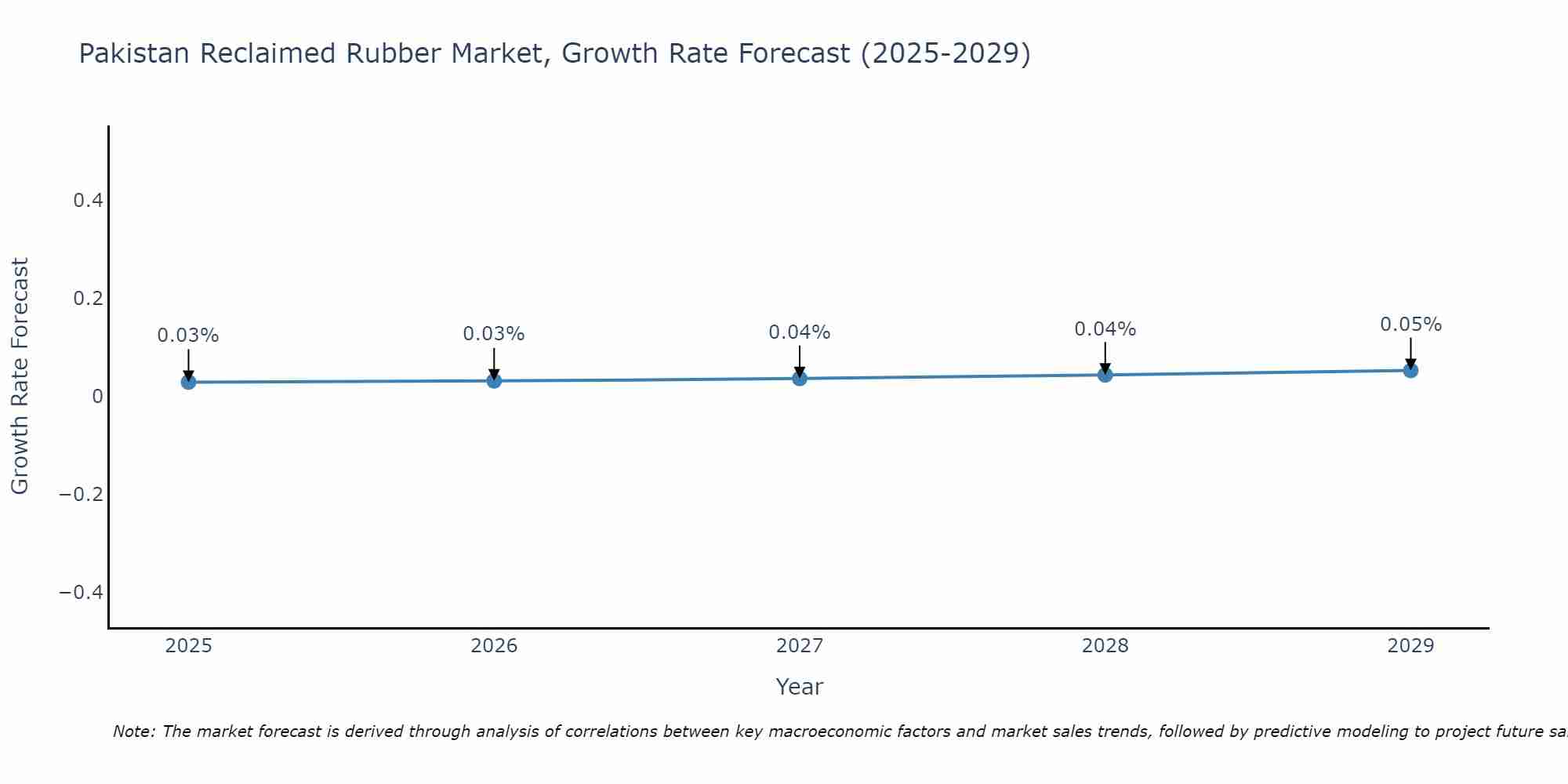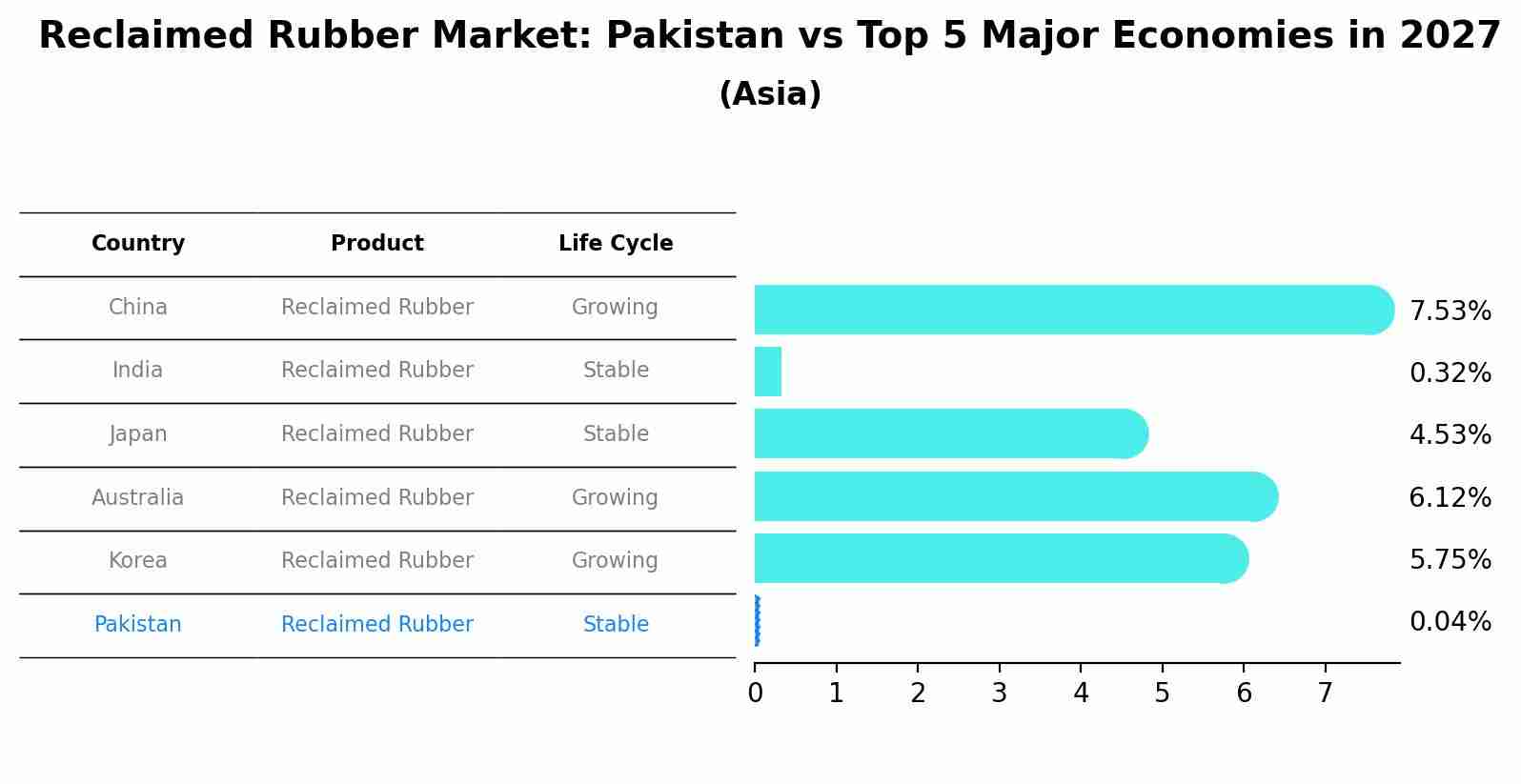Pakistan Reclaimed Rubber Market Outlook | Value, Companies, Size, Analysis, Revenue, Growth, Trends, Forecast, COVID-19 IMPACT, Share & Industry
| Product Code: ETC096236 | Publication Date: Jun 2021 | Updated Date: Apr 2025 | Product Type: Report | |
| Publisher: 6Wresearch | Author: Ravi Bhandari | No. of Pages: 70 | No. of Figures: 35 | No. of Tables: 5 |
Pakistan Reclaimed Rubber Market Size Growth Rate
The Pakistan Reclaimed Rubber Market is likely to experience consistent growth rate gains over the period 2025 to 2029. From 0.03% in 2025, the growth rate steadily ascends to 0.05% in 2029.

Reclaimed Rubber Market: Pakistan vs Top 5 Major Economies in 2027 (Asia)
In the Asia region, the Reclaimed Rubber market in Pakistan is projected to expand at a stable growth rate of 0.04% by 2027. The largest economy is China, followed by India, Japan, Australia and South Korea.

Pakistan Reclaimed Rubber Market Overview
In Pakistan, the reclaimed rubber market is expanding as industries seek sustainable and cost-effective alternatives to virgin rubber. Reclaimed rubber, derived from recycled rubber products, finds extensive applications in tire manufacturing, automotive components, and construction materials, driving its market growth in Pakistan.
Drivers of the market
The Reclaimed Rubber Market in Pakistan is expanding with the growing focus on sustainable and eco-friendly materials in various industries, including automotive, construction, and manufacturing. Reclaimed rubber is produced from recycled rubber products and offers cost-effective and environmentally friendly alternatives to virgin rubber. The market is driven by the increasing environmental awareness, stringent regulations on waste disposal, and the growing demand for recycled materials in rubber manufacturing processes. Additionally, advancements in recycling technologies and tire recycling initiatives contribute to market growth by enhancing the quality and versatility of reclaimed rubber products.
Challenges of the market
The reclaimed rubber market in Pakistan faces challenges associated with quality control, competition from cheaper imports, and environmental regulations. While reclaimed rubber offers cost-saving benefits and environmental advantages compared to virgin rubber, concerns about product consistency, durability, and performance limit its acceptance among manufacturers and end-users in Pakistan. Moreover, the influx of low-quality reclaimed rubber from foreign markets and the lack of stringent regulatory oversight pose challenges for local producers seeking to maintain high standards of product quality and safety.
Government Policy of the market
The Pakistan reclaimed rubber market is shaped by government policies aimed at promoting sustainable rubber recycling practices and reducing environmental impact. Policies focus on incentivizing the collection, processing, and utilization of reclaimed rubber from scrap tires and other rubber products. Regulatory frameworks set standards for quality, safety, and performance of reclaimed rubber to ensure its suitability for various industrial applications. Additionally, policies may include tax incentives, subsidies, and research grants to support innovation in rubber recycling technologies and infrastructure development. Government initiatives also emphasize public awareness campaigns on the benefits of using reclaimed rubber and its role in waste management and resource conservation.
Key Highlights of the Report:
- Pakistan Reclaimed Rubber Market Outlook
- Market Size of Pakistan Reclaimed Rubber Market, 2024
- Forecast of Pakistan Reclaimed Rubber Market, 2031
- Historical Data and Forecast of Pakistan Reclaimed Rubber Revenues & Volume for the Period 2018 - 2031
- Pakistan Reclaimed Rubber Market Trend Evolution
- Pakistan Reclaimed Rubber Market Drivers and Challenges
- Pakistan Reclaimed Rubber Price Trends
- Pakistan Reclaimed Rubber Porter's Five Forces
- Pakistan Reclaimed Rubber Industry Life Cycle
- Historical Data and Forecast of Pakistan Reclaimed Rubber Market Revenues & Volume By Product for the Period 2018 - 2031
- Historical Data and Forecast of Pakistan Reclaimed Rubber Market Revenues & Volume By Whole Tire Reclaim (WTR) for the Period 2018 - 2031
- Historical Data and Forecast of Pakistan Reclaimed Rubber Market Revenues & Volume By Butyl Reclaim for the Period 2018 - 2031
- Historical Data and Forecast of Pakistan Reclaimed Rubber Market Revenues & Volume By EPDM for the Period 2018 - 2031
- Historical Data and Forecast of Pakistan Reclaimed Rubber Market Revenues & Volume By Drab & Colored for the Period 2018 - 2031
- Historical Data and Forecast of Pakistan Reclaimed Rubber Market Revenues & Volume By Others for the Period 2018 - 2031
- Historical Data and Forecast of Pakistan Reclaimed Rubber Market Revenues & Volume By Application for the Period 2018 - 2031
- Historical Data and Forecast of Pakistan Reclaimed Rubber Market Revenues & Volume By Automotive & Aircraft Tires for the Period 2018 - 2031
- Historical Data and Forecast of Pakistan Reclaimed Rubber Market Revenues & Volume By Cycle Tires for the Period 2018 - 2031
- Historical Data and Forecast of Pakistan Reclaimed Rubber Market Revenues & Volume By Retreading for the Period 2018 - 2031
- Historical Data and Forecast of Pakistan Reclaimed Rubber Market Revenues & Volume By Belts & Hoses for the Period 2018 - 2031
- Historical Data and Forecast of Pakistan Reclaimed Rubber Market Revenues & Volume By Footwear for the Period 2018 - 2031
- Historical Data and Forecast of Pakistan Reclaimed Rubber Market Revenues & Volume By Molded Goods for the Period 2018 - 2031
- Historical Data and Forecast of Pakistan Reclaimed Rubber Market Revenues & Volume By Others for the Period 2018 - 2031
- Pakistan Reclaimed Rubber Import Export Trade Statistics
- Market Opportunity Assessment By Product
- Market Opportunity Assessment By Application
- Pakistan Reclaimed Rubber Top Companies Market Share
- Pakistan Reclaimed Rubber Competitive Benchmarking By Technical and Operational Parameters
- Pakistan Reclaimed Rubber Company Profiles
- Pakistan Reclaimed Rubber Key Strategic Recommendations
Frequently Asked Questions About the Market Study (FAQs):
1 Executive Summary |
2 Introduction |
2.1 Key Highlights of the Report |
2.2 Report Description |
2.3 Market Scope & Segmentation |
2.4 Research Methodology |
2.5 Assumptions |
3 Pakistan Reclaimed Rubber Market Overview |
3.1 Pakistan Country Macro Economic Indicators |
3.2 Pakistan Reclaimed Rubber Market Revenues & Volume, 2021 & 2031F |
3.3 Pakistan Reclaimed Rubber Market - Industry Life Cycle |
3.4 Pakistan Reclaimed Rubber Market - Porter's Five Forces |
3.5 Pakistan Reclaimed Rubber Market Revenues & Volume Share, By Product, 2021 & 2031F |
3.6 Pakistan Reclaimed Rubber Market Revenues & Volume Share, By Application, 2021 & 2031F |
4 Pakistan Reclaimed Rubber Market Dynamics |
4.1 Impact Analysis |
4.2 Market Drivers |
4.3 Market Restraints |
5 Pakistan Reclaimed Rubber Market Trends |
6 Pakistan Reclaimed Rubber Market, By Types |
6.1 Pakistan Reclaimed Rubber Market, By Product |
6.1.1 Overview and Analysis |
6.1.2 Pakistan Reclaimed Rubber Market Revenues & Volume, By Product, 2021-2031F |
6.1.3 Pakistan Reclaimed Rubber Market Revenues & Volume, By Whole Tire Reclaim (WTR), 2021-2031F |
6.1.4 Pakistan Reclaimed Rubber Market Revenues & Volume, By Butyl Reclaim, 2021-2031F |
6.1.5 Pakistan Reclaimed Rubber Market Revenues & Volume, By EPDM, 2021-2031F |
6.1.6 Pakistan Reclaimed Rubber Market Revenues & Volume, By Drab & Colored, 2021-2031F |
6.1.7 Pakistan Reclaimed Rubber Market Revenues & Volume, By Others, 2021-2031F |
6.2 Pakistan Reclaimed Rubber Market, By Application |
6.2.1 Overview and Analysis |
6.2.2 Pakistan Reclaimed Rubber Market Revenues & Volume, By Automotive & Aircraft Tires, 2021-2031F |
6.2.3 Pakistan Reclaimed Rubber Market Revenues & Volume, By Cycle Tires, 2021-2031F |
6.2.4 Pakistan Reclaimed Rubber Market Revenues & Volume, By Retreading, 2021-2031F |
6.2.5 Pakistan Reclaimed Rubber Market Revenues & Volume, By Belts & Hoses, 2021-2031F |
6.2.6 Pakistan Reclaimed Rubber Market Revenues & Volume, By Footwear, 2021-2031F |
6.2.7 Pakistan Reclaimed Rubber Market Revenues & Volume, By Molded Goods, 2021-2031F |
7 Pakistan Reclaimed Rubber Market Import-Export Trade Statistics |
7.1 Pakistan Reclaimed Rubber Market Export to Major Countries |
7.2 Pakistan Reclaimed Rubber Market Imports from Major Countries |
8 Pakistan Reclaimed Rubber Market Key Performance Indicators |
9 Pakistan Reclaimed Rubber Market - Opportunity Assessment |
9.1 Pakistan Reclaimed Rubber Market Opportunity Assessment, By Product, 2021 & 2031F |
9.2 Pakistan Reclaimed Rubber Market Opportunity Assessment, By Application, 2021 & 2031F |
10 Pakistan Reclaimed Rubber Market - Competitive Landscape |
10.1 Pakistan Reclaimed Rubber Market Revenue Share, By Companies, 2024 |
10.2 Pakistan Reclaimed Rubber Market Competitive Benchmarking, By Operating and Technical Parameters |
11 Company Profiles |
12 Recommendations |
13 Disclaimer |
- Single User License$ 1,995
- Department License$ 2,400
- Site License$ 3,120
- Global License$ 3,795
Search
Related Reports
- Portugal Electronic Document Management Market (2025-2031) | Strategy, Consumer Insights, Analysis, Investment Trends, Opportunities, Growth, Size, Share, Industry, Revenue, Segments, Value, Segmentation, Supply, Forecast, Restraints, Outlook, Competition, Drivers, Trends, Demand, Pricing Analysis, Competitive, Strategic Insights, Companies, Challenges
- France Electronic Document Management Market (2025-2031) | Strategy, Consumer Insights, Analysis, Investment Trends, Opportunities, Growth, Size, Share, Industry, Revenue, Segments, Value, Segmentation, Supply, Forecast, Restraints, Outlook, Competition, Drivers, Trends, Demand, Pricing Analysis, Competitive, Strategic Insights, Companies, Challenges
- Portugal Occupational Health & Safety Services Market (2025-2031) | Strategy, Consumer Insights, Analysis, Investment Trends, Opportunities, Growth, Size, Share, Industry, Revenue, Segments, Value, Segmentation, Supply, Forecast, Restraints, Outlook, Competition, Drivers, Trends, Demand, Pricing Analysis, Competitive, Strategic Insights, Companies, Challenges
- Netherlands Occupational Health and Safety Services Market (2025-2031) | Strategy, Consumer Insights, Analysis, Investment Trends, Opportunities, Growth, Size, Share, Industry, Revenue, Segments, Value, Segmentation, Supply, Forecast, Restraints, Outlook, Competition, Drivers, Trends, Demand, Pricing Analysis, Competitive, Strategic Insights, Companies, Challenges
- Belgium and Luxembourg Facility Management Market (2025-2031) | Strategy, Consumer Insights, Analysis, Investment Trends, Opportunities, Growth, Size, Share, Industry, Revenue, Segments, Value, Segmentation, Supply, Forecast, Restraints, Outlook, Competition, Drivers, Trends, Demand, Pricing Analysis, Competitive, Strategic Insights, Companies, Challenges
- Russia Women Intimate Apparel Market (2025-2031) | Strategy, Consumer Insights, Analysis, Investment Trends, Opportunities, Growth, Size, Share, Industry, Revenue, Segments, Value, Segmentation, Supply, Forecast, Restraints, Outlook, Competition, Drivers, Trends, Demand, Pricing Analysis, Competitive, Strategic Insights, Companies, Challenges
- Africa Chocolate Market (2025-2031) | Size, Share, Trends, Growth, Revenue, Analysis, Forecast, industry & Outlook
- Global Hydroxychloroquine And Chloroquine Market (2025-2031) | Industry, Trends, Size, Outlook, Growth, Value, Companies, Revenue, Analysis, Share, Forecast
- Saudi Arabia Plant Maintenance Market (2025-2031) | Industry, Size, Growth, Revenue, Value, Companies, Forecast, Analysis, Share & Trends
- Taiwan Electric Truck Market (2025-2031) | Outlook, Industry, Revenue, Size, Forecast, Growth, Analysis, Share, Companies, Value & Trends
Industry Events and Analyst Meet
Our Clients
Whitepaper
- Middle East & Africa Commercial Security Market Click here to view more.
- Middle East & Africa Fire Safety Systems & Equipment Market Click here to view more.
- GCC Drone Market Click here to view more.
- Middle East Lighting Fixture Market Click here to view more.
- GCC Physical & Perimeter Security Market Click here to view more.
6WResearch In News
- Doha a strategic location for EV manufacturing hub: IPA Qatar
- Demand for luxury TVs surging in the GCC, says Samsung
- Empowering Growth: The Thriving Journey of Bangladesh’s Cable Industry
- Demand for luxury TVs surging in the GCC, says Samsung
- Video call with a traditional healer? Once unthinkable, it’s now common in South Africa
- Intelligent Buildings To Smooth GCC’s Path To Net Zero













